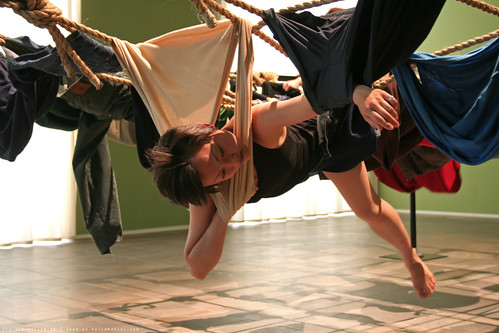Less easy to miss was the performance room in the Museum Fridericianum. No visitor could fail to hear the Grateful Dead's “Uncle John's Band” wafting from the 2nd floor. Follow those summer sounds, and you would've seen this.
As a preliminary comment, I hear this is exactly what a semester at Sarah Lawrence looks like. Now, I don't know a thing about modern dance, but documenta presented Brown as like THE pivotal figure in the field. I wonder, though, what someone in the dance field would say. Anyway, I kinda dug it.
The performance begins with little fanfare, the dancers wandering to their places, looking like nothing so much as comfortably-dressed documenta visitors. And no stage or designated performance space separates them from the documenta visitors. Museum security plays no role. So when the music comes on and the dancing begins, it's smack in the middle of a crowd, and in fact some spectators are “trapped” by the implied performance space, unable to leave the room without walking through the middle of the dance. Certainly the routine is sorely lacking in the pizazz pyrotechnics you might find in a J.Lo video or Britney Spears VMA performance - oops! strike that! But if you watch the above video you'll notice that the seemingly simple dance routine is structured on a succession of additions. The first additions are mostly minor – a hand motion or a twist of the waist. As the performance continues, the additions remain small, but the dance routine comes to require more and more space. This video doesn't really illustrate my point, but as this happens, the crowd of spectators gets pushed, slowly, further and further from the dancers. People step back, often crowding into fellow onlookers, out of anxiety that their position in the room violates the assumed physical boundaries of the performance. So while the music quickly draws a crowd, the dancing slowly pushes it outward, and this was very interesting to me. I found myself rushing to the room each time I heard the music, to watch the reactions of the audience if nothing else. That and, y'know, to get my Grateful Dead dance on.
One gawker in particular stood out: the creepy older guy who defiantly positioned himself so that the leotarded young dancer would repeatedly touch him in the execution of her routine. He stopped short of holding out a tightly creased five Euro bill, but you get the idea. Unphased, the dancer continued her performance as though oblivious to his presence. (The man and his conspicuously nonplussed wife had a public spat afterwards.)
 Between each regularly scheduled dance, and in the same room, there was also a performance involving some sort of jungle gym of rope and old clothing. Here, the same dancers climbed from one garment to the next, easing into each as dictated by the conventions of the article of clothing (legs go in pants, heads through collars, arms into sleeves, etc.), and hanging from the structure for several minutes before moving on and in to another piece of clothing. The same piece was performed at Seattle's Henry Art Gallery a couple years back, I'm told. No hippie soundtrack to this one, though. Like I said, I don't know a thing about modern dance....
Between each regularly scheduled dance, and in the same room, there was also a performance involving some sort of jungle gym of rope and old clothing. Here, the same dancers climbed from one garment to the next, easing into each as dictated by the conventions of the article of clothing (legs go in pants, heads through collars, arms into sleeves, etc.), and hanging from the structure for several minutes before moving on and in to another piece of clothing. The same piece was performed at Seattle's Henry Art Gallery a couple years back, I'm told. No hippie soundtrack to this one, though. Like I said, I don't know a thing about modern dance....
2 comments:
I find it upsetting that these european "artists" would string up dead people like that for all to see... we don't put up with that kind of crap in America.
Now if you'll excuse me, I've got some good, healthy, American movie watching to do... Saw IV is coming to theaters.
Your disturbed mind unnerves me, Aaron. But, to America's defense (er, sorta), the 'Saw' series and its ilk is wildly popular here in Germany as well, perhaps even moreso than in the US (don't quote me on that, just a passing observation). It seems that witnessing torture is a pastime that transcends borders and languages.
Post a Comment